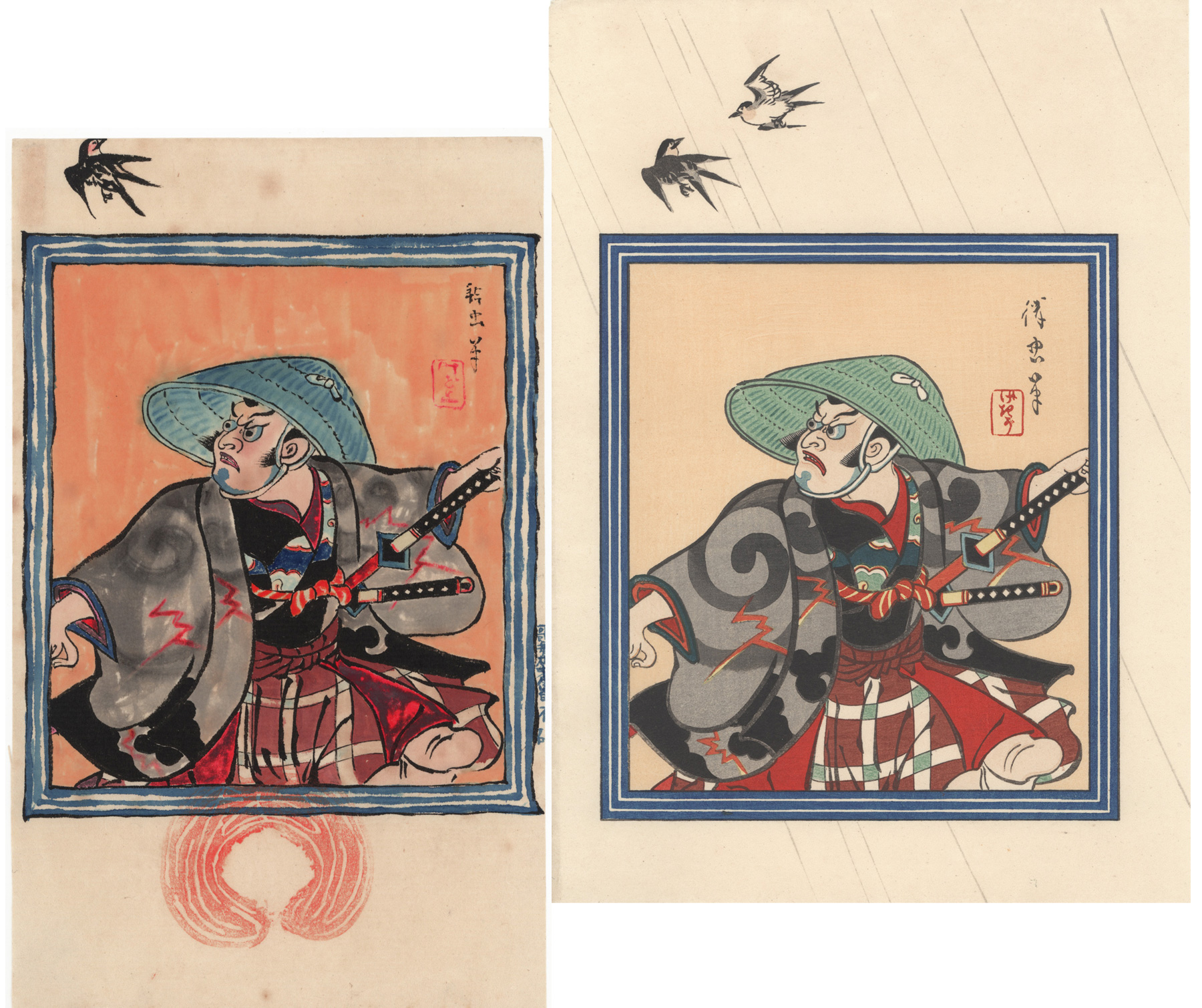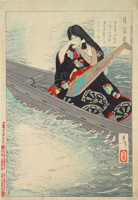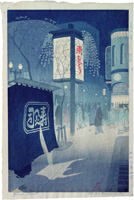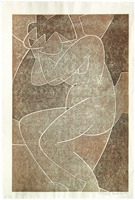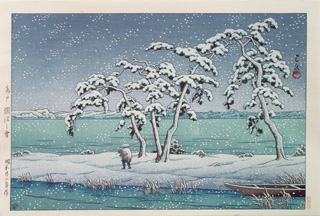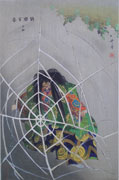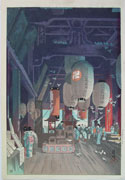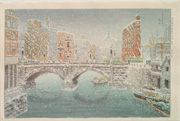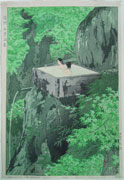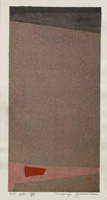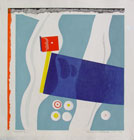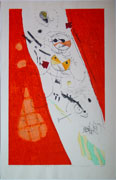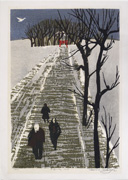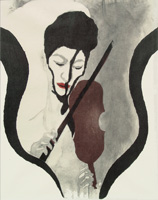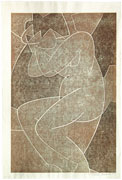Note
This site is in-process and is being made public with roughly 90% of the collection on-line.
Please check back as additions will continually be made.
Contact me at ihl@myjapanesehanga.com
INPUT/OUTPUT
(Preparatory watercolor and final print)
Fuwa Banzaemon (The Unbreakable) from the series Kabuki Jūhachiban, 1916
歌舞伎十八番 不破伴左衛門
by Torii Kiyotada VII 鳥居清忠 (七代目) (1875-1941)
Traditional woodblock printmaking was a "project" brought to fruition by a team consisting of publisher, artist, carver and printer. The publisher was the project leader who commissioned the artist to create a design which was then turned into a print by carvers and printers under the publisher's employ.
Above, on the left, is the preparatory watercolor painting by the artist Torii Kiyotada used by the carver and printer as a guide for creating the final print, seen on the right. Click on the image to get a close up view of the similarities and differences between the two.
And we wouldn’t be able to study Japanese art, it seems to me, without becoming much happier and more cheerful, and it makes us return to nature, despite our education and our work in a world of convention. - Vincent van Gogh in a letter to Theo van Gogh; Arles, Sunday, 23 or Monday, 24 September 1888 |
Overview
Acollection of over two thousand Japanese prints, spanning approximately one hundred years from the Meiji era (1868-1912) through the 1970s. The prints fall into threegenres, ukiyo-e (prints of the floating world), shin hanga (newprints), and sōsaku hanga (creative prints). (Find out more about these genres in the article A Very Brief Introduction to Ukiyo-e, Shin Hanga and Sōsaku Hanga.)
About This Collection
As you browse through these prints you'll see a wide range of artists, styles and subject matter. In my fifteen years of collecting, I have bought what strikes my fancy and fits my pocket book. This strategy does not a great collection make, but it has afforded me a certain freedom to explore new artists and genres and has led, I hope, to an interesting and representative collection of woodblock prints covering a roughly 100 year period.One of the wonderful things about collecting Japanese woodblock prints is the availability of countless thousands of designs created by hundreds, if not thousands, of talented artists. Each print has a bit of story to go with it, which I have tried to ferret out and record in these pages and, of course, each artist also has a story, which I have also tried to portray (within the limits of my non-Japanese reading/speaking ability.) As I discover, or you tell me about, more information on the artists and prints, I’ll add it.
Sometimes, I think that I am running a “print pound” or “emergency room” for prints, taking in prints in poor condition and at least stabilizing them and preventing further damage. I do treat each print with respect, for the artist and the object. For years I have assaulted friends and acquaintances with print showings. Everyone is always polite, despite my tendency to go on and on, as I am enthusiastic about Japanese prints.
I started collecting after seeing the 1998 exhibition at the Asian Art Museum of San Francisco of Hiroshige and Hokusai prints drawn from the James A. Michener Collection, Honolulu Academy of Arts.1 In the Museum’s gift shop were a number of shrink-wrapped Japanese prints, both reprints and originals of ukiyo-e works and shin hanga landscapes. While I did not purchase a print at the show, seeing that the print prices were within my budget did lead me to Frank Castle’s gallery Castle Fine Arts, Inc. in San Francisco and the purchase of my first print Snow at Hi Marsh, Mito by the artist Kawase Hasui (1883-1957). Twenty years and 2000 plus prints later I am as excited by the prospect of adding a new print to my collection as I was on that trip to San Francisco to purchase my first print.
1 For a walk through that exhibition go to https://education.asianart.org/resources/hokusai-and-hiroshige-great-japanese-prints-from-the-james-a-michener-collection/
History and Legends
Theater
War
Scenic Beauty and Famous Places
Abstract and Modern
Woodblock Printed Books
Excellent:The color is not faded. Well cut lines with registration good in allcolor blocks. The inking is even, unbroken, not blurred, with nobuild-up of ink at edges of color areas. The paper is intact withlittle or no damage. No discoloration of paper is evident.
Good:The color is relatively unfaded. Basically well-cut with only minorflaws in registration and inking. Little or minor physical damage tothe paper. Only very minor discoloration of paper is evident.
Fair:Color somewhat faded. General overall flaws in inking and registration,or unsightly localized flaws such as smudges or lines blurred together,and possible flaws in block cutting and wear from extensive printing.More than minor physical damage such as losses, stains, folds andabrasions. Discoloration of paper evident.
Poor: Colorconsiderably faded. Overall sloppy registration and printing, withobvious wear in the block. Major and unsightly damages to the paper. Significant discoloration to the paper.
There are two indices for this site - one lists all the artists in alphabetical order (last name first) and the other is a visual index of the prints in the collection arranged by artist. You can reach these indices by clicking on their icons that appear at the bottom of each page.
The following three icons also appear on the bottom of each page as an aid to site navigation.
If you'd like to discuss any aspect of the site email me at: ihl@myjapanesehanga.com
I'll do my best to get back to you.
Thanks for looking!
Irwin Lavenberg
A Few of My Favorites
History and Legends
Theater
War
Scenic Beauty and Famous Places
| | IHL Cat. #35 | Shirahone Hotspring, Shinshu, 1935 Kasamatsu Shiro (1898–1991) IHL cat #37 |
Abstract and Modern
| Ground No. 3, 1959 Yoshida Masaji (1917–1971) IHL Cat. #148 | Seabathing, 1970 Takahashi Rikio (1917-1999) IHL Cat. #424 | Flying angel No. 3, 1970 Hagiwara Hideo (1913 - 2007) IHL Cat. #318 |
| People of the Snow Country, 1978 Takagi Shiro (1934-1998) IHL Cat. #639 | Impression of a Violinist, 1947 (Portrait Of Suwa Nejiko) Onchi Koshiro (1891-1955) IHL Cat. #116 | IHL Cat. #202 |
Woodblock Printed Books
A Note on Condition
Thereis little agreement upon the use and meaning of various descriptors forconveying the condition of a Japanese print. Commonly used descriptorsare pristine, excellent, very good, good, moderately good, fair andpoor. I've used the following guidelines to determine a print's condition (an overall assessment of the print's quality).Excellent:The color is not faded. Well cut lines with registration good in allcolor blocks. The inking is even, unbroken, not blurred, with nobuild-up of ink at edges of color areas. The paper is intact withlittle or no damage. No discoloration of paper is evident.
Good:The color is relatively unfaded. Basically well-cut with only minorflaws in registration and inking. Little or minor physical damage tothe paper. Only very minor discoloration of paper is evident.
Fair:Color somewhat faded. General overall flaws in inking and registration,or unsightly localized flaws such as smudges or lines blurred together,and possible flaws in block cutting and wear from extensive printing.More than minor physical damage such as losses, stains, folds andabrasions. Discoloration of paper evident.
Poor: Colorconsiderably faded. Overall sloppy registration and printing, withobvious wear in the block. Major and unsightly damages to the paper. Significant discoloration to the paper.
Website Navigation
Thumbnail images of prints in the collection appear at the top of the page for each artist. Clicking on the thumbnail will take you to the page containing details of that print. Clicking on the image of the print will allow you to see an enlarged and detailed view of the print. Prints embedded in the explanatory text for an artist are, generally, not prints in the collection.There are two indices for this site - one lists all the artists in alphabetical order (last name first) and the other is a visual index of the prints in the collection arranged by artist. You can reach these indices by clicking on their icons that appear at the bottom of each page.
The following three icons also appear on the bottom of each page as an aid to site navigation.
Links have been embedded for cross-reference to relevant material appearing elsewhere on this site. Occasionally there is a link to another site. Links to other sites may not be current.
About This Website
This website is purely for my and your entertainment, education and discourse. There is no commercial intent. There is little, if any, original research contained in these hundreds of web pages. The information has mostly been culled from books, catalogs and a few websites. Whenever possible, I have cited the sources and provided the links for the information presented. If you notice something which should have attribution and does not, please let me know the details and I will add them. As to the images of prints not in my collection, the source of the image is not always known or available. If there is any concern about the use of a particular image, please let me know. If you notice any errors please let me know, along with your suggested correction. If you have additional information on any of the prints or artists on the site and want to share that, please contact me.If you'd like to discuss any aspect of the site email me at: ihl@myjapanesehanga.com
I'll do my best to get back to you.
Thanks for looking!
Irwin Lavenberg
アーウィソ ラべンバ ーグ
